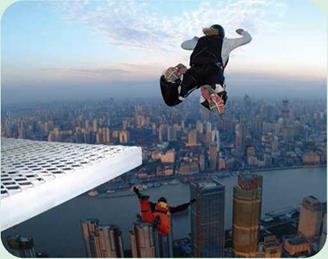Safety and Regulation
Although accidents do happen, skydiving and parachute sports have a good safety record. Accidents are most common when people jump in poor weather conditions, such as unpredictable winds. Jumping from buildings, cliffs, or other high structures (known as BASE jumping) is especially dangerous. Because the modern parachute can be steered, there is little chance of the parachutist landing accidentally in a lake or a tree, as was often the fate of parachutists in the past.
Drop zones in the United States and Canada are required to have an experienced person who acts as a safety officer. In most countries, skydivers are required to carry a reserve parachute that has been packed and inspected by a certified parachute rigger. In the United States, certification is provided by the Federal Aviation Administration (FAA).
Many countries have national parachuting associations, affiliated to the Federation Aeronautique Internationale (FAI). In the United States, skydiving permits and ratings are issued by the United States Parachute Association.
EXTREME SKYDIVING
Specialized forms of skydiving and parachuting include:
• Accuracy landing: Aiming to land on or very near a drop zone target.
• Blade running: Like slalom skiing with a parachute.
• Formation skydiving: Also called relative work (RW).
• Paraskiing: Landing on a snowy mountain on skis.
• Skysurfing: Landing with a surfboard strapped to the feet.
• Stuff jumping: Jumping with
 |
an object, such as a bicycle, which is ridden through the air before the sky – diver lets go and opens the parachute.
|
|
|
О A skydiver BASE jumps from one of the world’s tallest buildings in Shanghai, China. The "BASE" in BASE jumping is an acronym that stands for building, antenna, span, and Earth. |











